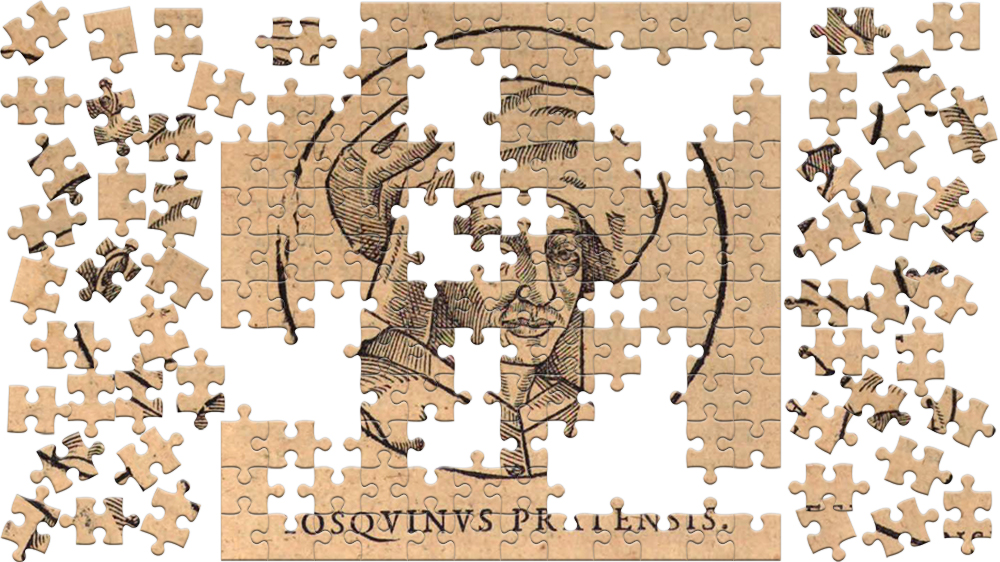
Josquin’s biography is clearly more complex than the Josquin puzzle with 144 pieces, but similarly incomplete. The number of reliable dates and documents is relatively small. In a biography of Josquin Desprez, words like “probably” and “possibly” are frequently found.
To remain in the language of the puzzle: many pieces (sources) are irretrievably missing and we have to rely on circumstantial evidence to obtain a chronological picture of his life. Because of his fame, there are a number of anecdotes handed down posthumously whose veracity is questionable. Confusions with composers and singers of similar name are added.
Since a uniform spelling is lacking and latinisations of his name also differ, confusion is inevitable. Eric Jas and Willem Elders, the editors of the volume “Sources” (NJE, vol. 1, p. xiii) have listed the different spellings of his name in the sources:
Jo., Jod., Jodocum, J.p., Jos., Jus, Jus’, Josquin, Josqvin, Josequin, Jossquin, Joss Quin, Josquyn, Josq.,Josqn,Josq’n,Josqu.,Joschin,Josfim,Joskin,Josqin,Josquini,Josquino,Josquinus,,Jo. de Pres, Jo. des Pres, Jo. des Prez, Josquin de Pres, Josquini de Pres, Josquin de Press, Josquin de Prees, Josquin de Preess, Josq. de Prees, Josquin dez Pres, Josquin des Prets, Josquin des Prez, Jossequin des Prez, Josquin des Pretz, Josquin du Prees, Josquin du Press, Josquin D., Jos. Depres, Josquin Depres, Josquin Deprecz, Josquin Depraes, Josquin Despres, Jusquin, Jusquini, Jusquin de Pres, Jusquin Depres, Jusquin Despret, Josquin ä Prato, Josquinus Pratensis, Jo. de Pratis, Jodoci Pratensis, Jodoco Pratensi, Jodocum Pratensem, Jodocus a Prato, Jodocus de Pratis, Judocus de Pratis, Jodocus de Prato, Jodocus Pratensis, Josquin Dascanio, Joskin Dascanio, Jusquin Dascanio.
Relatively few works are found in contemporary sources. Misattributions are common. With his death, the transmission of his works increased significantly, i.e. a large part of his works only survive in sources written after his death.
It was not until the late 1990s that Josquin was shown to have been born around 1450 (and not as early as 1440, as had been assumed since the mid-1950s). It was also possible to differentiate Josquin Desprez from three other persons with similar names who were confused with Josquin Desprez in the second half of the 20th century and formed a common biography:
- Juschinus de Kessalia, who had been an adult singer at Milan Cathedral since 1459. Due to the confusion with Josquin Desprez, it was assumed that Josquin was already born in 1440, as he would only have been of age if he had been born this early.
- Johannes Stokem, member of the papal chapel between 1486 and 1487 and listed there as “Joh. de Pratis”. Due to the confusion with Johannes Stokem, it was assumed for many years that Josquin Desprez had already been active in Rome since 1486 (and not only since 1489).
- Josquin Steelant, singer in the chapel of René II, Duke of Lorraine, in the 1490s. From May 1504 until his death in 1520, he was a member of the Burgundian court chapel.
Today we may assume that Josquin was born near Saint-Quentin in France and it is certain that he died on 27 August 1521 in Condé-sur-L’Escaut. Josquin is the diminutive of Josse (Latin Judocus) and the name of a Breton saint. Josquin’s surname was Lebloitte, Desprez was probably an epithet also used by his father and grandfather. They (or their ancestors) could have come from Prez, a place nearby, which would explain the byname.
Although the presumed place of birth could be reached from the definitive place of death in under five hours by horse-drawn carriage and this suggests a quiet life, in the meantime Josquin travelled thousands of kilometres, served king(s), princes and the Pope, scratched his name into the wooden benches of the Sistine Chapel, was praised by the reformer Luther for his music and survived a plague epidemic. Most importantly, however, he (or someone else) composed some of the most beautiful works in the history of music.
The following table summarises the current state of research (essentially Fallows 2009) on the most important stations in his life:
| Year | Activity |
|---|---|
| ca. 1450 | Birth near Saint-Quentin |
| seit ca 1460 | Possible training at Saint Géry in Cambrai |
| 1475-ca. 1480 | Member of the chapel of King René of Anjou in Aix-en-Provence |
| 1480-1483 | Member of the court chapel of King Louis XI in Paris / Condé |
| 1484-1489 | Member of the household of Cardinal Ascanio Sforza in Milan and possibly working for the King of Hungary (during his stay in Vienna) |
| 1489-ca. 1494 | Member of the Papal Chapel in Rome |
| 1494-1503 | Activity in France possibly in the service of Cardinal Ascanio Sofia in Rome |
| 1503-1504 | Member of the chapel of Duke Ercole d’Este in Ferrara |
| 1504-1521 | Provost at the Collegiate Church of Condé-sur-Escaut |
| 27.8.1521 | Death in Condé-sur-Escaut |
The employment in the court chapel of King Louis XI in Paris and Condé and especially the activity for the King of Hungary is still disputed due to the sources. His whereabouts in the years 1494 to 1503 are also uncertain. There is evidence of stays in France during this period, but it is not clear whether these were longer visits or appointments there or in Italy.
While in the past it was assumed that the Italian sojourns lasted considerably longer, it is now assumed that Josquin spent the majority of his life in France.
The best overview of all sources, the circumstantial evidence in favour of activities in the court chapel of King Louis XI and in the chapel of the King of Hungary, as well as indications as to which works can be assigned to which stations of life, can be found in Fallows 2009. Since the publication of the book, there has been no significant discovery of sources that has changed the factual situation, but there have been many divergent interpretations, some of which can be found in the reviews of the book.